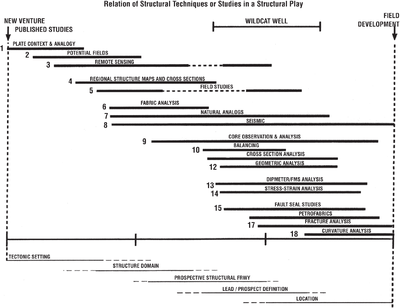How different structural philosophies govern techniques
| Exploring for Oil and Gas Traps | |

| |
| Series | Treatise in Petroleum Geology |
|---|---|
| Part | Predicting the occurrence of oil and gas traps |
| Chapter | Exploring for structural traps |
| Author | R.A. Nelson, T.L. Patton, S. Serra |
| Link | Web page |
| Store | AAPG Store |
There are several major philosophies or approaches to structural geology, and various university departments and E&P companies favor one or another in their courses and approaches to problem-solving. The major approaches can be grouped into four major categories:
- Global tectonics
- Structural styles
- Detailed geometric and/or kinematic studies
- Mechanical or dynamic approaches
The individual techniques presented in this section and highlighted in Figure 1 span the range of these categories. A complete E&P structural study, therefore, includes aspects of all four.
Different organizations; different philosophies
Exploration and production organizations usually display strength or focus in perhaps one or two of the above category areas or focus on different areas of the technologies timeline. For example: organizations that emphasize global tectonics (including basin analysis) and structural styles probably display particular strength in new ventures and effective concession acquisition, whereas those that emphasize mechanical structural approaches probably have great success in development geology. Those emphasizing detailed geometric analyses probably work more in the central portions of Figure 1 and effectively pick wildcat and first follow-up well locations.
Matching strength to strategy
Organizations should understand their strengths and areas of focus in their structural plays and supplement them in other areas by judiciously using complementary consultants, strategic alliances, and partnership agreements. Each player, then, brings the strength and focus necessary to conduct the effective structural play.
In this way, Figure 1 can be a tool for effective project planning when deciding which studies need to be done in-house, which ones should be done by various support organizations and partners, and when these studies should be initiated and completed.
